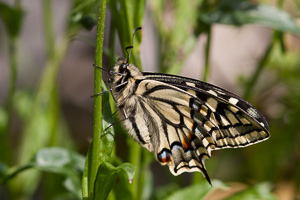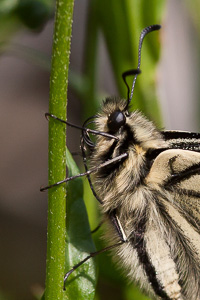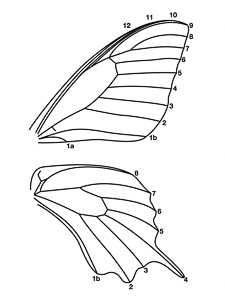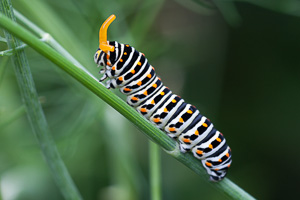| Family: | Papilionidae | Latreille, 1802 |
| Subfamily: | Papilioninae | Latreille, 1802 |
| Type Genus: | Papilio | Linnaeus, 1758 |
This family contains the largest butterflies in the world, including the birdwings of the Troides and Ornithoptera, the latter including Queen Alexandra's Birdwing (Ornithoptera alexandrae), the largest butterfly in the world. This family is found in all zoogeographical regions and contains over 500 species, with the various genera differing widely in terms of appearance and behavior. Although the majority of species in this family are tailed, and known collectively as the "swallowtails", a considerable number are not, such as the apollos and festoons.
The antennae are relatively short for the size of the butterfly, and the club at the end of the antenna is often curved and with a blunt apex. The eyes are smooth and the labial palps are variable, but are typically short, comprised of dense hairs and ascending. All legs are fully-functional in both sexes, each leg possessing a pair of claws.
 |  |
Swallowtail (Papilio machaon) | Swallowtail (Papilio machaon) |
The venation of the Papilionidae is unique in that, in the majority of species, veins 1a and 1c on the forewing are both very short, with vein 1c found near the base of the wing. The hindwing usually has a single anal vein, with vein 4 extending into the tail for those species that are tailed and vein 8 connecting to the cell near its base. The hindwing inner margin is concave and the adjacent wing is hairy. Androconial scales are absent in all European species.
 |
Swallowtail (Papilio machaon) |
Eggs are spherical or hemispherical with a granular surface. Larvae are varied, but are usually in possession of an osmeterium, a defence mechanism comprising a retractable and fleshy forked organ found in the first thoracic segment and that gives off an odour. While variable, the pupa is typically secured in an upright position, attached to a surface by a silken girdle and by the cremaster to a silken pad.
 |
Swallowtail (Papilio machaon) |
Description to be completed.
This subfamily is represented by the following tribes:
This subfamily is represented by the following genera:
This subfamily is represented by the species shown below.